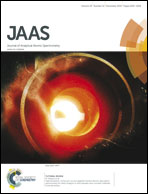Preconcentration and determination of manganese in biological samples by dual-cloud point extraction coupled with flame atomic absorption spectrometry
Abstract
An efficient, innovative preconcentration method using dual-cloud point extraction (d-CPE) was developed for the analysis of trace levels of manganese (Mn2+) in biological samples (scalp hair) prior to coupling with flame atomic absorption spectrometry (FAAS). In the first step of d-CPE, Mn2+ was complexed with 1-(2-pyridylazo)-2-naphthol (PAN), which was subsequently entrapped in a nonionic surfactant (Triton X-114). In the second step, the entrapped metal complex in the surfactant-rich phase was treated with aqueous nitric acid solution and heated; the studied metal ions were back-extracted again into aqueous phase. The aqueous phase was subjected to FAAS using conventional nebulization. The validity of the proposed method was verified by the analysis of Mn2+ in a certified sample of scalp hair (CRM) by both d-CPE and conventional CPE procedures. The enhancement factor of Mn2+ was found to be 46. The proposed method was successfully applied to the determination of Mn2+ in acid-digested scalp hair samples of Parkinson's patients and healthy referents.


 Please wait while we load your content...
Please wait while we load your content...